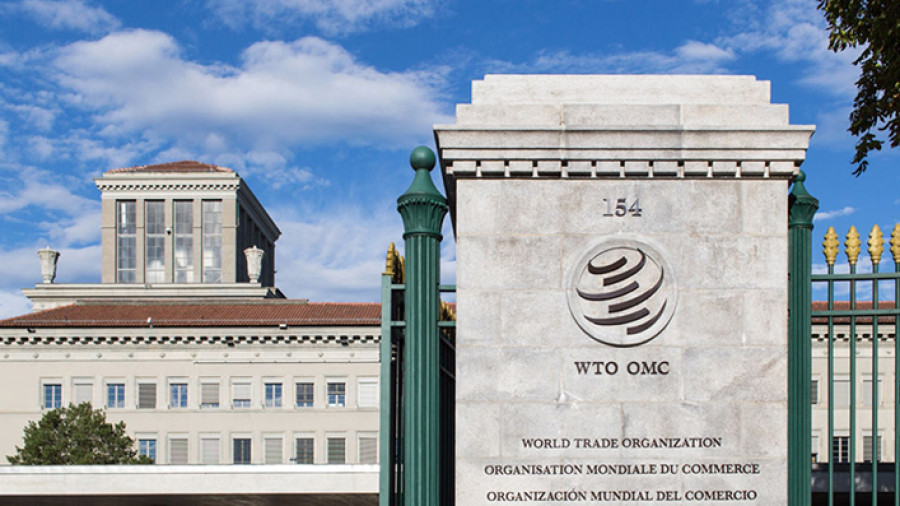Columns
Nepal, WTO and challenges
Nepal’s fate in the WTO will depend on its trade efficiency and policy.
Bijendra Man Shakya
Nepal’s membership in the World Trade Organization (WTO), a multilateral trading system, marked 20 years in April 2024. After 14 years of an arduous accession process that began in 1989, the fifth WTO Ministerial Meeting in 2003 approved Nepal's membership, and the country formally joined the organisation in April 2004 after the government ratified it.
Nepal had two main reasons to enter into the multilateral trading system, despite its complexities. First, it was indispensable for Nepal to fill the void in its external trade caused by the termination of its trade and transit agreements with India, which shared almost 90 percent of the country’s external trade at that time. Second, the multilateral trading system could help diversify Nepal’s India-dominated external trade with third countries, as stipulated in its plans and policies until the late 80s.
Nepal’s objectives in joining the WTO were to guarantee transit rights and trade diversification under non-discriminatory treatment in trade with its partners, as assured by the basic norms of the multilateral trading system. However, Nepal’s affiliation to the WTO can also be evaluated for other reasons.
When Nepal joined the WTO, the WTO Doha Round of trade negotiations, initiated in 2001 (yet to be concluded), was at the centre of global attention because it embraced the interests of both developed and developing countries. The Doha Round has special bearings for Nepal. Renowned for the understanding to cut agriculture subsidies and tariffs as well as to improve market access for non-agriculture products, the essence of the Doha Round for the least-developed countries (LDCs), including Nepal, rested on the introduction of preferential market access for the first time under the multilateral system. It was later incorporated into the Doha agenda as a duty- and quota-free programme. The agenda included trade capacity building provision through the Aid for Trade programme to compensate for trade losses of such countries due to the erosion of preference as world average tariff rates are reduced under the multilateral system.
This suggested that the value of trade preference would diminish with the erosion of preference margins for Nepal’s trade, whereas the preference would gradually lose its importance after Nepal graduates from LDC status in 2026. The LDC-specific preference is not permitted for non-LDCs under different preferential schemes, including the popular Generalised System of Preference programme. Thus, Nepal’s fate in the WTO will eventually depend on its trade efficiency and trade policy rather than the preferential treatment.
Nepal must do many things to reap the benefits of its WTO membership. First and foremost, it is necessary to assess our bilateral trade agreements vis-à-vis the country’s current trade regime, which is already under the multilateral system. Except for the trade treaty with India, Nepal’s other bilateral agreements seem redundant in this context. Nepal’s trade agreement with India includes partially reciprocal trade preferences at its core and goes deeper than the multilateral system. However, the rest of the others are confined to the most favoured nation (MFN) treatment concerning customs tariffs and trade procedures, almost equivalent to the WTO’s MFN treatment or the principle of trade without discrimination. That means such agreements are superfluous unless they have distinctive features from the WTO system.
Therefore, Nepal should revise the bilateral agreements, giving due consideration to the issues that do not fall under the WTO mechanism. For example, the bilateral trade negotiations could be an effective means to sort out the problem of non-tariff measures (NTMs), which are intense in Nepal’s trade enhancement and diversification initiative. The NTMs have been problematic even during the WTO negotiations. Paradoxically, the domestically ingrained NTMs are more detrimental to Nepal’s trade endeavour than the non-tariff barriers subjected to its trade with partners, according to a study by the International Trade Centre.
In addition to the challenges, there is a rationale behind Nepal’s membership in the WTO. One of the most significant aspects is the predictable trading environment guaranteed by the WTO principles, which are based on non-discrimination, fair trade and transparency. Furthermore, in the case of unfair trade practices, the WTO has contingency measures, such as anti-dumping and countervailing duties, to defend the country’s trade interests from such incidents. And there is a powerful dispute settlement mechanism at its disposal to sort out the trade wrangling, if any. These measures are worthwhile as the country’s trade expands.
It is worth mentioning some achievements Nepal made after entering the WTO. Backed by the policy of free trade, Nepal’s exports have grown steadily in the face of escalated import trade since it pursued the multilateralism policy. The liberalisation of import trade has helped the country diversify its exports through comparative advantage. Nepal’s achievement in the area of service trade cannot be undermined with respect to export prospects and diversification. Besides these accomplishments, Nepal has also made strides in trade-related laws. While the rules on intellectual property rights—one of the strict WTO requirements—have been introduced, the laws dealing with competition and anti-dumping, which are prerequisites to international business, are also effective now.
However, this is not the end of the challenges. Nepal’s benefits from WTO membership will rely on its dedication to an enabling trading environment. This will also depend on its ability to adapt to the multilateral trading system, which is facing a credibility crisis following the Doha deadlock and the growing threat of protectionism in recent years.




 18.12°C Kathmandu
18.12°C Kathmandu













%20(1).jpg&w=300&height=200)

